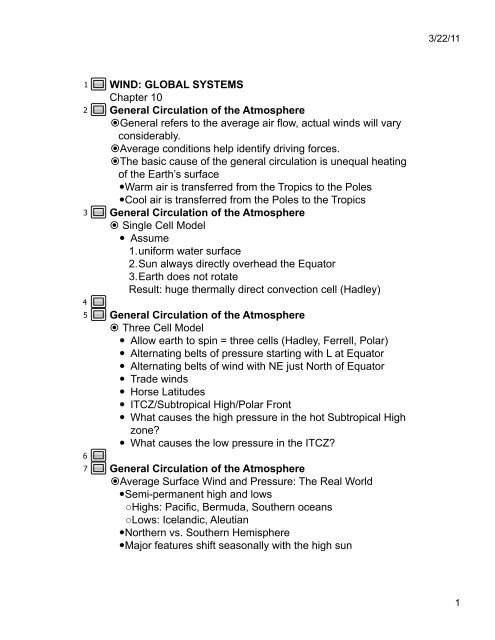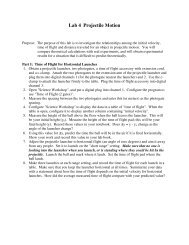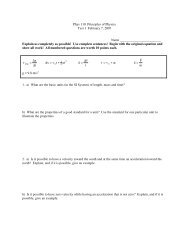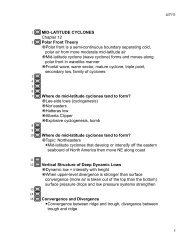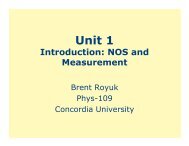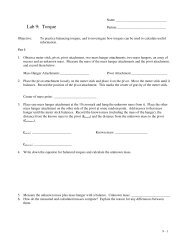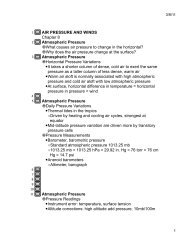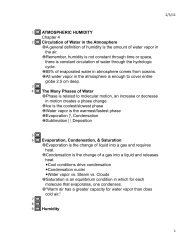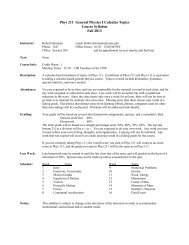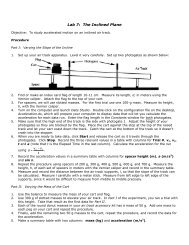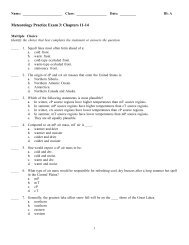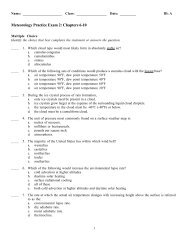WIND: GLOBAL SYSTEMS Chapter 10 General Circulation of the ...
WIND: GLOBAL SYSTEMS Chapter 10 General Circulation of the ...
WIND: GLOBAL SYSTEMS Chapter 10 General Circulation of the ...
You also want an ePaper? Increase the reach of your titles
YUMPU automatically turns print PDFs into web optimized ePapers that Google loves.
3/22/111234567<strong>WIND</strong>: <strong>GLOBAL</strong> <strong>SYSTEMS</strong><strong>Chapter</strong> <strong>10</strong><strong>General</strong> <strong>Circulation</strong> <strong>of</strong> <strong>the</strong> Atmosphere <strong>General</strong> refers to <strong>the</strong> average air flow, actual winds will varyconsiderably. Average conditions help identify driving forces. The basic cause <strong>of</strong> <strong>the</strong> general circulation is unequal heating<strong>of</strong> <strong>the</strong> Earth’s surface Warm air is transferred from <strong>the</strong> Tropics to <strong>the</strong> Poles Cool air is transferred from <strong>the</strong> Poles to <strong>the</strong> Tropics<strong>General</strong> <strong>Circulation</strong> <strong>of</strong> <strong>the</strong> Atmosphere Single Cell Model Assume1. uniform water surface2. Sun always directly overhead <strong>the</strong> Equator3. Earth does not rotateResult: huge <strong>the</strong>rmally direct convection cell (Hadley)<strong>General</strong> <strong>Circulation</strong> <strong>of</strong> <strong>the</strong> Atmosphere Three Cell Model Allow earth to spin = three cells (Hadley, Ferrell, Polar) Alternating belts <strong>of</strong> pressure starting with L at Equator Alternating belts <strong>of</strong> wind with NE just North <strong>of</strong> Equator Trade winds Horse Latitudes ITCZ/Subtropical High/Polar Front What causes <strong>the</strong> high pressure in <strong>the</strong> hot Subtropical Highzone? What causes <strong>the</strong> low pressure in <strong>the</strong> ITCZ?<strong>General</strong> <strong>Circulation</strong> <strong>of</strong> <strong>the</strong> Atmosphere Average Surface Wind and Pressure: The Real World Semi-permanent high and lows○ Highs: Pacific, Bermuda, Sou<strong>the</strong>rn oceans○ Lows: Icelandic, Aleutian Nor<strong>the</strong>rn vs. Sou<strong>the</strong>rn Hemisphere Major features shift seasonally with <strong>the</strong> high sun○ North in July, South in Decembe89<strong>10</strong>111
3/22/11 Major features shift seasonally with <strong>the</strong> high sun○ North in July, South in Decembe○ Regional highs in Canada and Siberia in winter89<strong>10</strong>1112131415161718192021222324<strong>General</strong> <strong>Circulation</strong> <strong>of</strong> <strong>the</strong> Atmosphere <strong>General</strong> <strong>Circulation</strong> and Precipitation Patterns Rain where air rises (low pressure) Less rain where air sinks (high pressure)<strong>General</strong> <strong>Circulation</strong> <strong>of</strong> <strong>the</strong> Atmosphere Average Wind Flow and Pressure Patterns Al<strong>of</strong>t North-South temperature and pressure gradient at highaltitudes creates West-East winds, particularly at mid to highlatitudes.Jet Streams <strong>10</strong>0-200 kt winds at <strong>10</strong>-15km, thousands <strong>of</strong> km long, several<strong>10</strong>0 km wide and a few km thick (polar and subtropical)Jet Streams Polar and Subtropical Jet Established by steep temperature and pressure gradientsbetween circulation cells. Between tropical-mid-latitude cell (subtropical) and midlatitude-polarcell (polar) Gradients greatest at polar jetJet Streams Topic: Momentum Low-latitudes: atmosphere gains momentum High-latitudes: atmosphere losses momentum252
23243/22/11252627282930313233343536373839 Low-latitudes: atmosphere gains momentum High-latitudes: atmosphere losses momentum Conservation <strong>of</strong> MomentumAtmosphere Ocean Interactions Global Winds and Surface Ocean Currents Ocean surface dragged by wind, basins react to highpressure circulation forming gyres Cold current, flowing north to south, on west side <strong>of</strong> continent Warm current, flowing south to north, on east side <strong>of</strong>continent Oceanic frontAtmosphere Ocean Interactions Upwelling Ekman spiral, Ekman transport Water moving away from <strong>the</strong> coast causes upwellingAtmosphere Ocean Interactions El Nino and <strong>the</strong> Sou<strong>the</strong>rn Oscillation El Nino: irregular warm episode <strong>of</strong>f west coast <strong>of</strong> SouthAmerica Sou<strong>the</strong>rn Oscillation: rise in pressure over W Pacific, fall in<strong>the</strong> E Pacific, equatorial countercurrent ENSO La Nina Teleconnections: Ocean/atmosphere interactions thatinfluence precipitation patterns in distant parts <strong>of</strong> <strong>the</strong> worldAtmosphere Ocean Interactions34041
3435363738394041Atmosphere Ocean Interactions Pacific Decadal Oscillation Reversal in Pacific Ocean temperatures Warm = more Pacific storms Cool = cool, wet NW North America, wetter over <strong>the</strong> GreatLakes, salmon fisheries declineAtmosphere Ocean Interactions North Atlantic Oscillation Reversal <strong>of</strong> pressure in North Atlantic Ocean affectingwea<strong>the</strong>r in Europe and eastern coast <strong>of</strong> North America Positive = strong Westerlies, storms in N Europe, wet andmild in eastern US Negative = wet sou<strong>the</strong>rn Europe and Mediterranean, coldand dry in eastern US3/22/114243444546Atmosphere Ocean Interaction Arctic Oscillation Closely related to NAO Pressure changes between Arctic and adjacent sou<strong>the</strong>rnareas causes changes upper-level winds Positive = mild winter in US and W Europe Negative = cold US, cold dry Europe, wet MediterraneanHomework for <strong>Chapter</strong> <strong>10</strong> <strong>Chapter</strong> <strong>10</strong> Questions for Review, p. 284 #3-5, 7, 15, 18 <strong>Chapter</strong> <strong>10</strong> Questions for Thought, p. 284 #4, 6 <strong>Chapter</strong> <strong>10</strong> Problems and Exercises, p. 284 NoneProject for <strong>Chapter</strong> 9 None4


